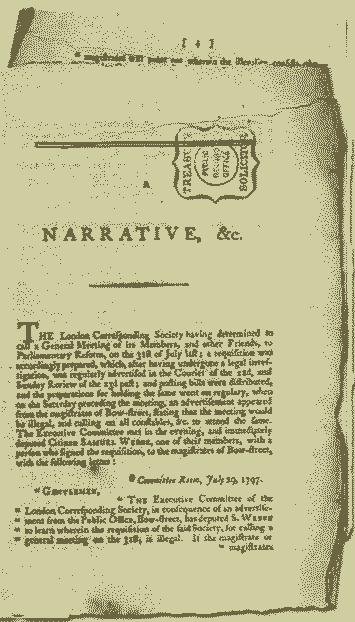London Corresponding Society
 By
the year 1792 England was still largely agrarian but there were increasing
numbers of people being employed in industry. The workers who had
moved to newly industrialized towns such as Manchester or Birmingham were
demoralized, because of overcrowded conditions. However they were not organized,
did not think politically, and there was little communication among them.
By
the year 1792 England was still largely agrarian but there were increasing
numbers of people being employed in industry. The workers who had
moved to newly industrialized towns such as Manchester or Birmingham were
demoralized, because of overcrowded conditions. However they were not organized,
did not think politically, and there was little communication among them.
While there had been previous efforts in the 1760s by democratic reformers to extend voting privileges and limit corruption by the King and parliament, the success was minimal and the efforts were dropped.
It was after the outbreak of the French Revolution in 1789 that workers in England began to understand their plight and began to see that there was something to do about it. Tom Paine, responding to the French uprisings wrote the Rights of Man in 1790-91 which he offered a program for radical change. In it he argued that public works could serve as a remedy for unemployment and provide social benefits, including financial allowances for children and the elderly. Paine's pamphlet was highly influential in helping people attribute their poverty and lack of power to social rather than natural conditions.
In January 1792 nine men met at Bell Tavern off the Strand in London to found the London Corresponding Society. The founder was Thomas Hardy, a shoemaker, who was concerned about "the heavy pressure of the daily accumulating taxes, and the consequent rise in the prices of all the necessaries of life."
The London Society focused on recruitment. It was organized in divisions, with each division expected to recruit up to 30 members, mostly tradesmen, mechanics, and shopkeepers-members of the lower middle and working class. Each member paid a small dues (and met weekly. Once a division had reached 30 members, a new division was formed. Among the functions of a division was to elect two delegates to send to a General Committee, made up of members of all of the divisions. Division meetings involved political discussion and communication with other reform groups (hence the term "correspondence")
The General Committee also met weekly and formed an executive committee from among its ranks. The executive committee consisted of six members, a secretary and a president. It also met every week.
The Society corresponded with similar societies in other towns in England that had been affected industrialization. Its membership grew to an estimated 2 to 20 thousand, mostly artisans (hatters, bakers, grocers, booksellers carpenters, watchmakers, shoemakers-called the middling class).
Their general aim was to organize working man to goals of reform movement. Specifically they advocated having annual parliaments, universal suffrage for men, and parliamentary reform
In May of 1792, King George III issued a proclamation warning people against seditious meetings and political libels.
In 1794, members of the Society planned a convention for the following summer. They planned to meet with other groups to discuss ways they might work together to obtain universal suffrage for men and annual parliaments.
William Pitt viewed this effort as an attempt to overthrow the English government. In May 1794, he had twelve of those engaged in the planning arrested for high treason. Some of those arrested were members of the London Corresponding Society, others members were from a more moderate group, the Society for Constitutional Information.
- John Baxter
- Augustus Bonney
- Thomas Hardy
- Thomas Holcroft
- Jeremiah Joyce
- Stewart Kyd
- John Lovett
- John Martin
- Francis Place
- John Richter
- John Thelwall
- John Home Tooke
The men were accused of committing an overt act showing intent to kill the king. The Lord Chief Justice Eyre, working on behalf of the King, interpreted the act of planning a convention as an intent to overthrow the government, thereby threatening the life of the king. Three of those arrested, Tooke, Hardy and Thelwall, were tried and acquitted based on the arguments of Thomas Erskine, a reform lawyer. They and the other nine who were arrested were released in December 1794.
The society continued to meet, despite further harassment from police, press gangs, newspapers, members in parliament. In 1790 parliament passed an act outlawing the Society by name. It was only then that the group stopped its activities.
References
Barrell, John (1992). Imaginary treason, imaginary law. The state trials of 1794. In J. Barrell (Ed.) The birth of Pandora and the division of knowledge (pp. 119-142). London: Macmillan.
Collins, Henry (1954) The London Corresponding Society. In John Saville, ed., Democracy and the Labour Movement (London, 1954), p. 132.
Parssinen, T. M (1973) Association Convention and Anti-Parliament in British Radical Politics, 1771-1848. English Historical Review 88, 504-33.
Thale, Mary (ed.) (1983). Selections from the papers of the London Corresponding Society 1792-1799. Cambridge: Cambridge University Press.
